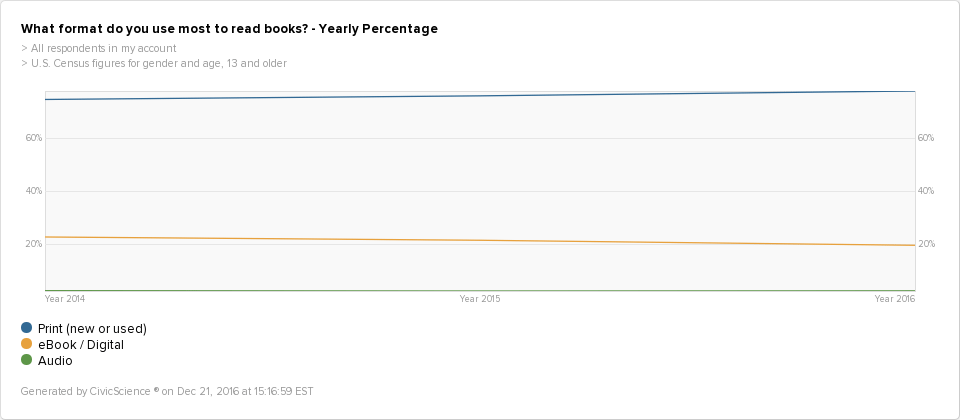Last week, a new study was published showing that children experience stronger benefits when parents read them print books, rather than digital books. More specifically, the researchers say that “the interaction of parent and child were found to be different […] When they read from paper rather than a screen, there was a significant increase in the warmth of the parent/child interactions: more laughter, more smiling, more shows of affection.”
This warmed my heart, personally, but also made me a bit sad. If print books are going extinct, as many seem to think they are, countless kids will miss out on an incredibly formative and positive experience, according to the new data.
So, I decided to look into book reading preferences, and I was pleasantly surprised! Take a look at these two graphs (which exclude non-readers):

 First thing to notice: 75% of Americans who read books most often read print books. Though digital books and new eReaders have been a huge hit, and though this number of people who read digital books is higher than 2008 figures, they still don’t seem to scrape the traditional reading experience.
First thing to notice: 75% of Americans who read books most often read print books. Though digital books and new eReaders have been a huge hit, and though this number of people who read digital books is higher than 2008 figures, they still don’t seem to scrape the traditional reading experience.
And here’s the second thing to notice: People who read books in print seem to be on the rise (slightly).
In 2015, 76% of respondents said they read print books most often, while that number today is 78%. Conversely, 22% of Americans said they read digital books most often in 2015, while that number today rests at 20%. These are small changes, of course, but notable nonetheless.
More specific to the study, take a look at this graph which is segmented to only include parents:
As you can see, the parents who most often read print books have grown more than the general population. In 2015, 75% of parents most often read print books, while that number today is 80%.
On a last positive note, we also found that people who like reading in general are on the rise, which echoes reports from the National Endowment for the Arts.
So, this might be good news for print book fans, not to mention the many kids who will grow up laughing and smiling with their parents or guardians over physical, timeless novels.
For digital book sales, this does signal a challenge. If digital books hope to succeed, they not only have to think about the ease and price of reading digitally, but on how to mimic the traditional bonding experiences of reading in print as well.
Interested in other insights? Check out our recent posts on last-minute holiday shoppers, the possible decline of dating apps, and the top parental fears.









